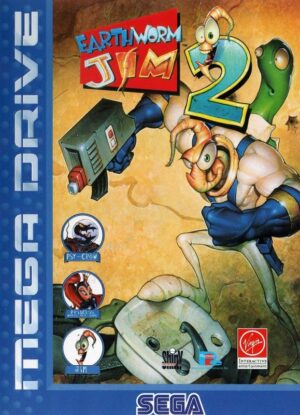Retro Replay Review
Gameplay
Dragon Warrior VII’s gameplay shines through its deep job system, offering a level of customization rare for its time. You can assign up to four party members to various jobs—from humble Fighters and Healers to exotic Monster Masters—each granting a unique set of skills and stat growth. As you master more abilities, you have the freedom to mix and match learned spells or techniques, creating synergies that reward experimentation. This robust system encourages players to revisit jobs even after reaching high levels to unlock hidden powers and fine-tune an optimized team.
(HEY YOU!! We hope you enjoy! We try not to run ads. So basically, this is a very expensive hobby running this site. Please consider joining us for updates, forums, and more. Network w/ us to make some cash or friends while retro gaming, and you can win some free retro games for posting. Okay, carry on 👍)
Exploration forms the backbone of Dragon Warrior VII’s gameplay loop. Starting on the tiny island of Estard, you soon gain access to a whole world of shattered continents floating in the void, and each landmass holds its own dungeons, towns, and secrets. The sense of discovery is palpable as you map out new islands, dive into underground caverns, and unlock ancient portals. Side quests abound—whether it’s helping a ghostly bride find peace or collecting rare items for eccentric NPCs—providing hours of additional content beyond the main narrative.
Combat adheres to a first-person, turn-based style that’s faithful to the series’ roots. Battles are paced deliberately, giving you time to plan spells, skills, and item usage. The challenge scales nicely: early skirmishes serve as tutorials, but later foes demand careful party composition and clever strategy. Also notable is the Monster Arena, which lets you capture and train enemies, then pit them against each other for unique rewards—adding a fun diversion for completionists and battle enthusiasts alike.
Progression balances story milestones with optional boss fights and hidden treasures. While some quests require backtracking to earlier islands, the game smartly integrates teleportation methods and hot-spots on the world map to keep travel from becoming tedious. Grinding can be time-consuming due to sparse experience bonuses in extra areas, but dedicated players will find character development gratifying once new spells and abilities unlock. Overall, the gameplay loop of exploring, battling, and job mastering forms one of Dragon Warrior VII’s most compelling draws.
Graphics
Dragon Warrior VII leverages the PlayStation’s hardware to deliver detailed pre-rendered backgrounds combined with 3D character models, creating a visually appealing tapestry that still holds nostalgic charm today. Towns and castles are painted with rich colors and intricate architecture, offering a sense of scale that belies the era. Every environment—from sun-bleached shores to ominous demon lairs—feels distinct, encouraging players to linger and appreciate the artistry.
Character models in battles are rendered in 3D, with smooth animations for spells and special moves. While the polygon count is modest by modern standards, the exaggerated designs and vibrant palettes ensure that each hero and villain stands out. Spell effects, such as swirling meteor showers or gleaming holy lights, remain satisfying to watch, lending weight to your party’s magical arsenal.
Sprite-based enemies on the world map and in dungeons lean heavily into the series’ cartoonish aesthetic. Monsters range from comical slimes to grotesque dragons, each modeled on classic Dragon Quest illustrations. Even with limited animation frames, the designs exude personality—particularly when you capture and train monsters yourself. It’s a testament to the art direction that these sprites feel alive despite technical constraints.
The user interface embraces simplicity: menus are clear, icons are easily distinguishable, and text boxes maintain readability throughout. There are no flashy HUD elements to distract from the world, letting the visuals and music take center stage. Although load times can be a bit lengthy when entering new areas, the payoff is worthwhile, as each new screen presents a handcrafted vista that invites exploration.
Story
At its heart, Dragon Warrior VII tells a tale of rediscovery. You begin as a 16-year-old fisherman’s son on the isolated island of Estard, content in your simple life alongside two childhood friends. The game wastes little time before upending that peace: a chance exploration reveals an ancient dish containing shards of a prism, hinting that your world once spanned far beyond this tiny atoll. From there, curiosity quickly becomes destiny as you embark on a quest to restore a fractured realm.
The narrative’s core device—time travel to various historical eras—lends the story a sense of mystery and grandeur. Each era spotlights a different culture and conflict, from the war-torn kingdoms of the past to the treacherous dungeons littered with forgotten weapons. As you collect and reassemble the prism’s fragments, you piece together a lost civilization’s triumphs and tragedies, gradually unveiling the calamity that shattered the world.
Character development is gradual but meaningful. Your companions, including a suave thief and a stoic martial artist, come with their own ambitions and backstories that intertwine with the broader plot. Side characters also receive attention: townsfolk plagued by personal woes or spectral figures seeking redemption flesh out the world’s emotional stakes. The story balances light-hearted banter with dramatic revelations, maintaining a warm, engaging tone throughout your journey.
Although pacing can lag in the middle segments—particularly during extended dungeons or repetitive side-quests—the payoff of discovering ancient truths and restoring lost lands is satisfying. Key cutscenes and boss battles punctuate the adventure with cinematic flair, making major story beats feel earned. Fans of classic JRPG narratives will appreciate the blend of epic quests, heartfelt moments, and the overarching theme of rekindling a forgotten world.
Overall Experience
Dragon Warrior VII stands as one of the most ambitious entries in the Dragon Quest series, marrying expansive exploration with a sophisticated job system. Its adherence to traditional mechanics—first-person turn-based combat, medieval settings, and sprite-driven encounters—evokes nostalgia while offering enough depth to engage modern players. The sense of wonder as you traverse floating continents and forgotten ruins remains one of the game’s most enduring qualities.
Despite its age, the game’s audiovisual presentation holds up through strong art direction and a memorable soundtrack filled with sweeping melodies from composer Koichi Sugiyama. While load times and occasional backtracking may test one’s patience, the world’s sheer scope and the abundance of side content make it a worthwhile commitment for fans of long, story-driven adventures.
Dragon Warrior VII’s combination of narrative richness, engaging gameplay systems, and charming aesthetic creates an experience that rewards exploration and experimentation. Whether you’re a veteran series fan curious about the original PlayStation era or a newcomer seeking a classic JRPG journey, this title offers dozens of hours of immersive play. The job mastery system alone provides ample incentive to revisit the world long after the main story concludes.
In summary, Dragon Warrior VII is a timeless epic that successfully builds upon its predecessors while carving out its own identity. Its layered mechanics, heartfelt storytelling, and lovingly crafted environments result in a captivating adventure. For players seeking a traditional role-playing experience with exceptional depth and scope, this is a game that still shines brightly decades after its initial release.
 Retro Replay Retro Replay gaming reviews, news, emulation, geek stuff and more!
Retro Replay Retro Replay gaming reviews, news, emulation, geek stuff and more!









Reviews
There are no reviews yet.